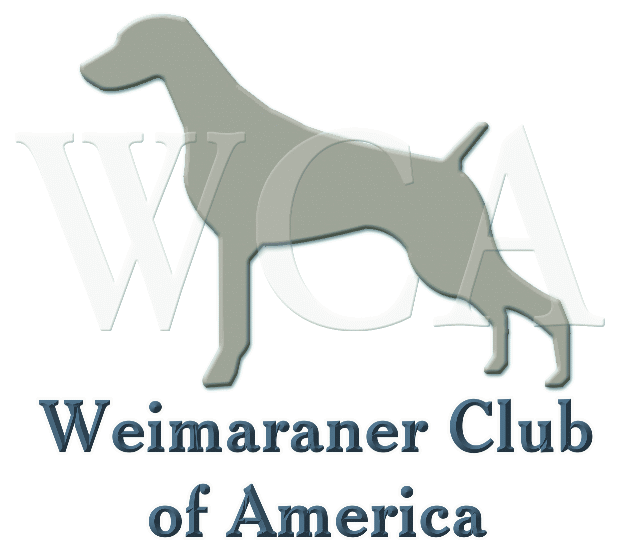

THE WEIMARANER
AN ILLUSTRATED STANDARD
Authorized and Approved by the
Weimaraner Club of America
Established 1943

Produced by the Weimaraner Club of America
Judges’ Education and Breeders’ Education Chairpersons
March, 2010
Kelly Photopoulos
Amy Anderson
Bonnie Lane
Along with Ginny Alexander
Illustrated by Linda J. Shaw and Lorna Godsill
Copyright 2010 Weimaraner Club of America, all rights reserved.
STANDARD: Approved December 14, 1971
Origin and Purpose
The Weimaraner breed dates back to 13th century art and literature. The Grand Duke of Weimar, for whom the breed is named, is responsible for standardizing the breed to its modern form. The Weimaraner developed into one of the prized continental hunting breeds during the 19th century, excelling with various types of game. They exhibited instinctive hunting abilities such as tracking, searching, pointing, retrieving and locating downed large game. What made the Weimaraner unique was its need for human companionship and kind handling. With the decline of big game along with the introduction of guns to bird hunting, Weimaraner breeders placed more emphasis on pointing instincts.
In 1896, Germany recognized the Weimaraner as a breed. Despite opposition from the German breed club, a few individual dogs came to North America in the first part of the 20th century. The breed was eventually recognized in the United States and Canada.
The Weimaraner is now used in Germany on all furred and feathered game. In North America, they are used almost exclusively on birds. The modern Weimaraner has maintained its stamina, hunting versatility and need for human bonding.
Official Standard – boldface
Interpretative Comments by Committee – Italic
General Appearance
 A medium–sized gray dog, with fine aristocratic features. He should present a picture of grace, speed, stamina, alertness and balance. Above all, the dog’s conformation must indicate the ability to work with great speed and endurance in the field.
A medium–sized gray dog, with fine aristocratic features. He should present a picture of grace, speed, stamina, alertness and balance. Above all, the dog’s conformation must indicate the ability to work with great speed and endurance in the field.
The opening description of the Weimaraner’s general appearance with its emphasis on functional qualities is the key to understanding the standard. Because the Germans emphasized functional ability rather than physical uniformity, there is considerable diversity within the breed. The Weimaraner is a medium sized silver–gray aristocratic dog. He should be well muscled and present a picture of grace and balance, dogs should be masculine, bitches feminine. All body parts should flow together without any part being out of proportion to the whole. (Weimaraner Ways)
Of utmost importance in discussing Weimaraner anatomy is the principle of never losing sight of the whole dog and the idea that no one part is ever more important than the sum of the dog’s parts.
Height
 Height at the withers: dogs, 25 to 27 inches; bitches, 23 to 25 inches. One inch over or under the specified height of each sex is allowable but should be penalized. Dogs measuring less than 24 inches or more than 28 inches and bitches measuring less than 22 inches or more than 26 inches shall be disqualified.
Height at the withers: dogs, 25 to 27 inches; bitches, 23 to 25 inches. One inch over or under the specified height of each sex is allowable but should be penalized. Dogs measuring less than 24 inches or more than 28 inches and bitches measuring less than 22 inches or more than 26 inches shall be disqualified.
Medium size with regard to height needs no explanation as it is clearly defined with a disqualification for those who deviate from this size. When compared to people and objects of known proportion, the medium size of the Weimaraner is apparent. Height is always measured from the withers to the ground.
Head
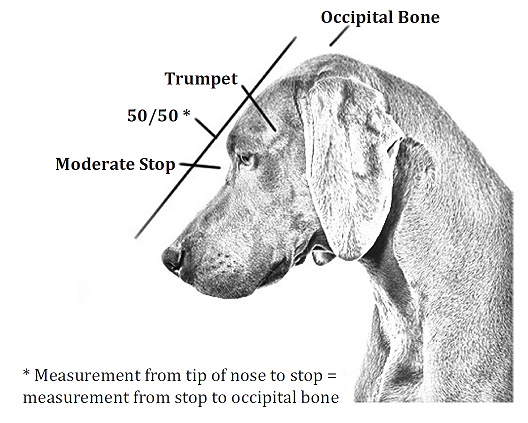 Moderately long and aristocratic, with moderate stop and slight median line extending back over the forehead. Rather prominent occipital bone and trumpets well set back, beginning at the back of the eye sockets. Measurement from the tip of nose to stop equals that from stop to occipital bone. The flews should be straight, delicate at the nostrils. Skin drawn tightly.
Moderately long and aristocratic, with moderate stop and slight median line extending back over the forehead. Rather prominent occipital bone and trumpets well set back, beginning at the back of the eye sockets. Measurement from the tip of nose to stop equals that from stop to occipital bone. The flews should be straight, delicate at the nostrils. Skin drawn tightly.
• Neck – clean–cut and moderately long
• Expression – kind, keen and intelligent
• Ears – Long and lobular, slightly folded and set high. The ear when drawn snugly alongside the jaw should end approximately 2 inches from the point of the nose.
• Eyes – In shades of light amber, gray or blue-gray, set well enough apart to indicate good disposition and intelligence. When dilated under excitement the eyes may appear almost black.
• Teeth – Well set, strong and even; well-developed and proportionate to jaw with correct scissors bite, the upper teeth protruding slightly over the lower teeth but not more than 1/16 of an inch. Complete dentition is greatly to be desired.
• Nose – Gray
• Lips and Gums – Pinkish flesh shades
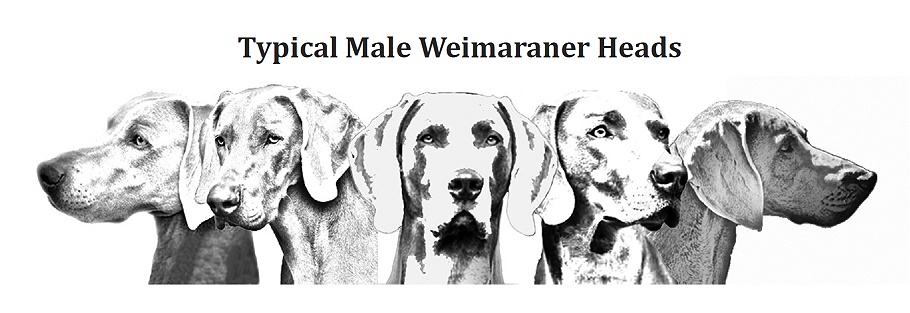
To complete the picture of grace, style and nobility, the head should be pleasing with a kind, intelligent expression and be in proportion to the body. Males distinctly masculine, females distinctly feminine. The head should be equal in muzzle length and back skull length.
The stop is moderate, but may give the impression of being deep due to the eyebrows which are prominent. There is an indentation or “median line” that runs the length of the back skull and stops at the somewhat prominent occipital bone. The trumpets, which are defined as the slight depression or hollow on either side of the skull just behind the orbit or eye socket (comparable to temples in man), give the head a chiseled appearance which adds to its attractiveness. The flews should be straight, not pendulous, and taper to the nostril. They should not give a snipey appearance.
A scenting bird dog should carry his head proudly with the planes of his muzzle parallel to the ground, which should enable the free flow of air back to his nostrils. Although it is not mentioned in the standard, any good bird dog needs large nostrils to better enable him to scent birds. Adequate stop is required for the Weimaraner to see over the bird during a retrieve. The neck should be long enough for the dog to easily reach down and pick up game. It should not be overly long or short. The ears should be long, reaching almost to the nose when pulled along the side of the muzzle. They are set high when the dog is at attention and are rounded at the tips.
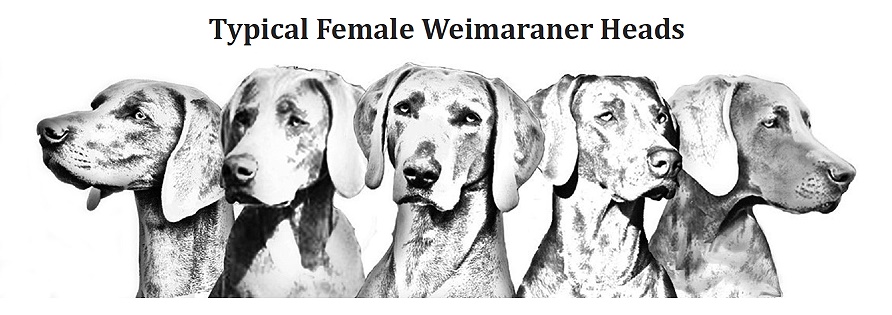
Body
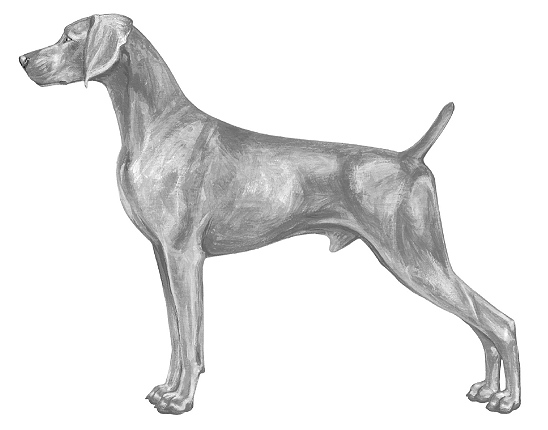 The back should be moderate in length, set in a straight line, strong, and should slope slightly from the withers. The chest should be well developed and deep with shoulders well laid back. Ribs well sprung and long. Abdomen firmly held; moderately tucked–up flank. The brisket should extend to the elbow.
The back should be moderate in length, set in a straight line, strong, and should slope slightly from the withers. The chest should be well developed and deep with shoulders well laid back. Ribs well sprung and long. Abdomen firmly held; moderately tucked–up flank. The brisket should extend to the elbow.
The Weimaraner standard clearly addresses depth of body, “the brisket should extend to the elbow,” and proportion of leg length, “forelegs…from the elbow to the ground approximately equaling the distance from the elbows to the top of the withers.” However, the Standard is vague with regard to body LENGTH which states only that the “…back is moderate in length.” Again, referring to the German’s emphasis on functionality, rather than physical uniformity, the height–length proportions of the breed, as well as substance, have always varied widely. In general the height–length proportions should convey the impression of pleasing balance that is confirmed by smooth coordination of the front and rear strides.” (Weimaraner Ways)
He is slightly longer than tall, with a moderately long neck going into well laid back shoulders, straight, slightly sloping backline, confident tail carriage and well–angulated rear. His chest should be well developed and deep giving him plenty of lung room. His depth of chest carries well back with a firmly held abdomen and moderately tucked-up flank. The backline should be firm while standing or moving.
While the Standard doesn’t specifically address neck structure, an arched neck is desirable as it is anatomically stronger. Strength is necessary to handle the pull of the shoulder blade muscles and to support the head while retrieving. A “ewe” neck is a neck in which the topline is concave rather than convex and is an anatomical weakness.
Coat and Color
Short, smooth and sleek, solid color, in shades of mouse–gray to silver–gray, usually blending to lighter shades on the head and ears. A small white marking on the chest is permitted, but should be penalized on any other portion of the body. White spots resulting from injury should not be penalized. A distinctly long coat is a disqualification. A distinctly blue or black coat is a disqualification.
Allowable white on the chest may be in the form of a spot or blaze, giving the appearance of being small and should not dominate the chest. Color should not give the appearance of being brown, liver or black. Coat color resembles a grayish–taupe and varies from very light shades to deep rich shades; all have the distinctive grayish–taupe tone, never a true brown or blue color. Lighter shading on the head and ears is referred to as the “Grafmar Cap”, and is more prominent with age. A distinctly long coat or a distinctly blue or black coat is a disqualification.
Weimaraners are avid sun bathers; their dilute coat color is easily sun bleached giving it a more brownish cast. In addition, a breed trait while shedding is a “bulleted/spotted” or mottled pattern, which will disappear with the new coat.
The Weimaraner coat color is a dilute; therefore, it is genetically impossible for a correctly–colored, gray Weimaraner to have a black–mottled mouth; it may have a gray mottled mouth.
| Blue | 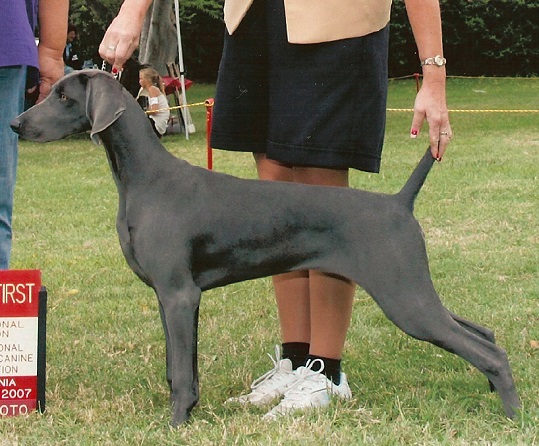 |
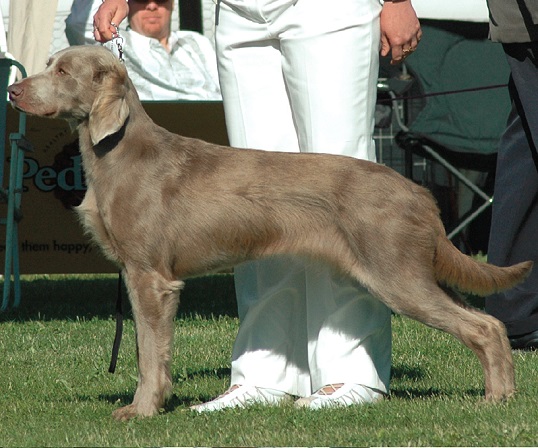 | Long Hair |
| Gray | 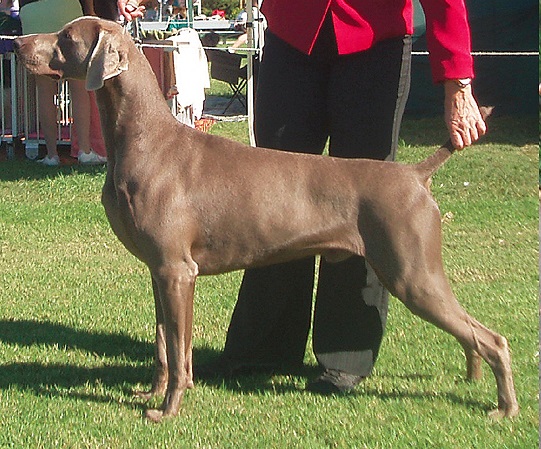 |
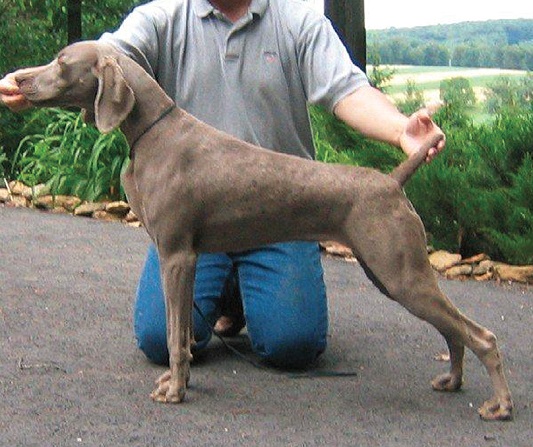 | Mottled Coat |
Forelegs
Straight and strong, with the measurement from the elbow to the ground approximately equaling the distance from the elbow to the top of the withers.
The pasterns should have a very slight bend, which absorb the impact of each foot fall when the dog is in motion. A pastern that is too upright, knuckled over, or broken down is unable to flex and cannot absorb the shock of the dog’s weight landing on the front assembly. The vertical line of support is from the front of the foreleg through the metacarpals, and to the rear of the pad.
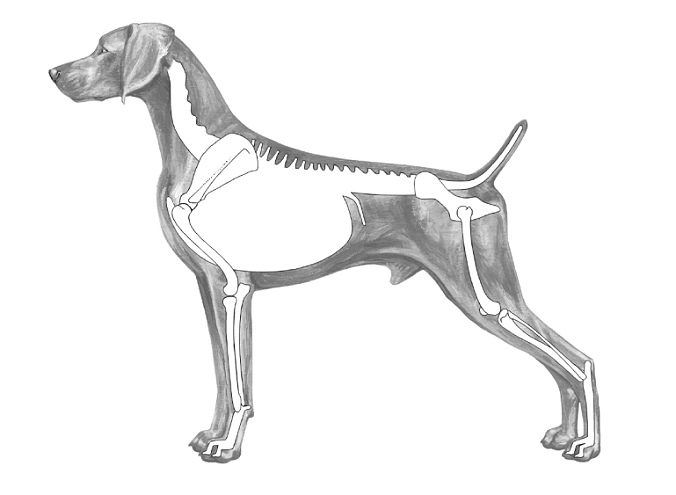
Hindquarters
Well–angulated stifles and straight hocks. Musculation well developed.
Well angulated stifle actually refers to the stifle joint, which is a hinge made by the upper thigh (femur) and lower thigh (tibia). Well-bent stifles normally result in longer rear reach, and also provide flexibility associated with speed. The rear angulation should balance with the correctly angled front assembly, balance being the key. The musculatures should be well defined, not soft or flabby. A well–angulated rear provides the long, ground covering stride desired in the hunting dog.
Feet
Firm and compact, webbed, toes well arched, pads closed and thick, nails short and gray or amber in color.
• Dewclaws – should be removed.
There is a variety of foot types in the breed, ranging from a very tight cat foot to a hare foot. The old horseman’s adage “no feet, no horse”, applies to sporting dogs as well. Sportsmen regard splayed feet as fatal to any hunting dog. Flat feet cannot grip the ground when slippery or if the dog must climb. Shallow pads are easily bruised or injured.
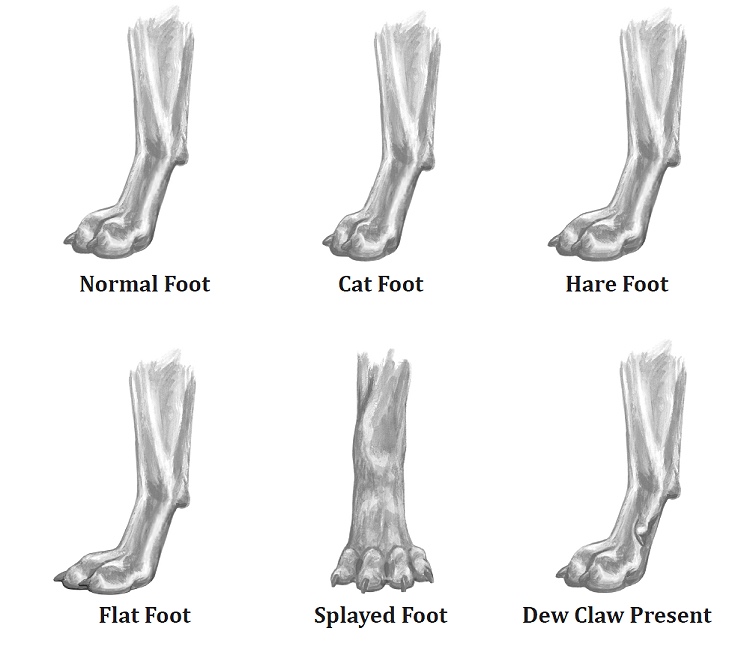
Tail
Docked. At maturity it should measure approximately 6 inches with a tendency to be light rather than heavy and should be carried in a manner expressing confidence and sound temperament. A non–docked tail shall be penalized.
Our standard is vague with regard to correct tail set, citing only that a low tail set is a major fault. The set–on of the tail correlates with the contour of the croup and pelvic angle. A low tail set indicates a steep pelvis which will result in restricted rear extension. A flat croup will result in the most rear extension but may cause excessive rear kick and wasted motion. A slightly angled croup will result in less extension but increased agility and endurance. Please do not confuse “tail set” , (an expression of structure) with “tail carriage” (an expression of temperament). Faults of docking are entirely man made thus, incorrect length is only a minor fault.
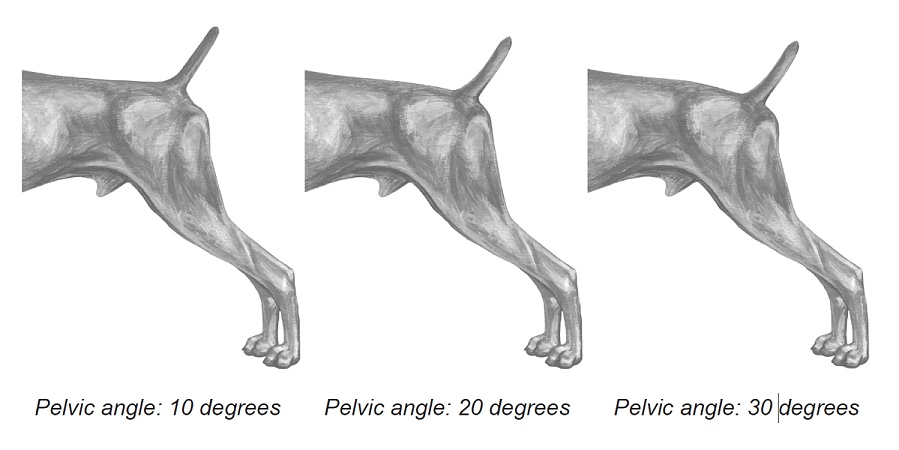
The subtle differences illustrated here demonstrate the range of acceptable tail sets which reflect the range of pelvic angles.
A pelvic angle of 40 degrees or more would result in a steep croup and low tail set which is a major fault.
Gait
The gait should be effortless and should indicate sooth coordination. When seen from the rear, the hind feet should be parallel to the front feet. When viewed from the side, the topline should remain strong and level.
To ensure that the Weimaraner can endure a day in the field, his gait must be smooth, coordinated and effortless. If his front angulation shaped by well laid back shoulders is correct and the rear angulation with well bent stifles is equal to the front, there should be no wasted motion. If front and rear angulation is not in balance, one end compensates for the other, resulting in inefficient movement.
A Weimaraner should easily cover ground with good reach in front and good drive in the rear. Restricted movement in any form is incorrect.
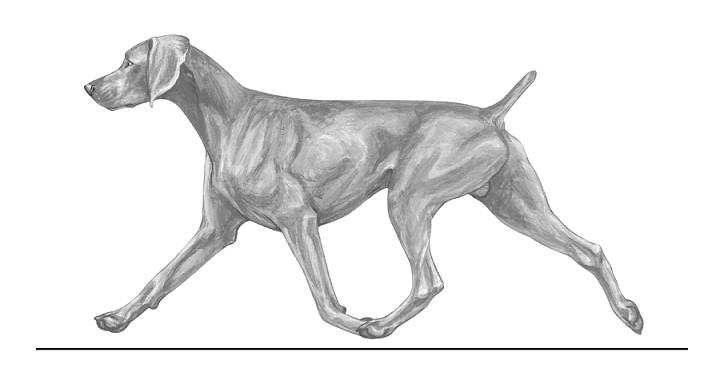
When viewed on the down and back, the Weimaraner’s legs converge toward a center line beneath his body in order to achieve balance; the greater the speed, the closer the legs come to tracking on a straight line.
Temperament
The temperament should be friendly, fearless, alert and obedient.
Although temperament is not considered part of physical anatomy, it is a critical feature of breed type and has a powerful effect on maximizing each dog’s unique energy output, front leg lift, and correct reach and drive. The Weimaraner should not show strong fear, shyness or extreme nervousness, as these are very serious faults. Temperament must be considered when evaluating the Weimaraner with some leeway given to inexperienced puppies and novice handlers.
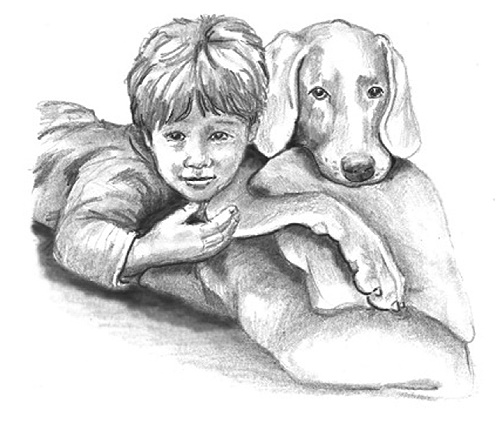
Minor Faults
Tail too short or too long. Pink nose.
Major Faults
Doggy bitches, Bitchy dogs. Improper muscular condition. Badly affected teeth. More than four teeth missing. Back too long or too short. Faulty coat. Neck too short, thick or throaty. Low–set tail. Elbows in or out. Feet east and west, Poor gait. Poor feet. Cowhocks. Faulty back, either roached or sway. Badly overshot, or undershot bite. Snipey muzzle. Short ears.
Very Serious Faults
White, other than a spot on the chest. Eyes other than gray, blue–gray or light amber. Black mottled mouth. Non–docked tail. Dogs exhibiting strong fear, shyness or extreme nervousness.
Disqualifications
Deviation in height of more than one inch from the standard either way. A distinctly long coat. A distinctly blue or black coat.
Download the WCA Illustrated Standard
